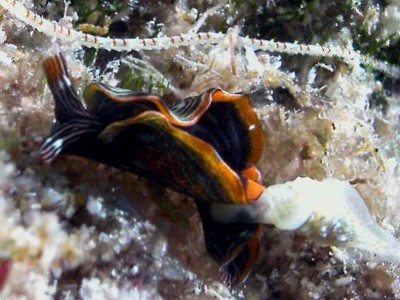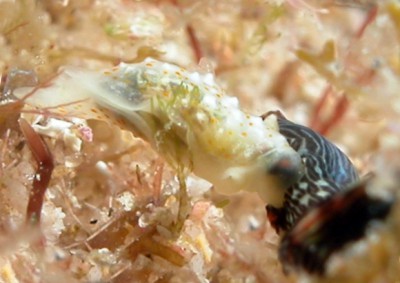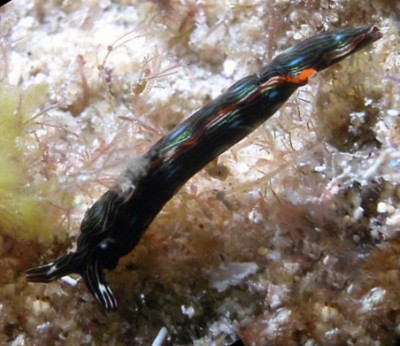Thuridilla gracilis from S. E. Queensland
May 14, 2010
From: David Mullins


Concerning message #22294:
Dear Bill,
On a dive trip to Flinders Reef off Moreton Island last year we found this specimen of Thuridilla gracilis in a life and death struggle with a specimen of Gymnodoris okinawae.
The G. okinawae had a mouthful of parapodium which can be seen through it's transparent buccal wall. The Thuridilla dragged the Gymnodorid around and around at top speed for approximately half an hour before finally managing to shake it off losing a piece of the parapodium in the process.
The longitudinal white lines on the parapodia tend to have a greenish tinge above the blue ovals which changes to an orange margin. I can see where confusion can easily arise when trying to classify these creatures according to the coloured markings on their body. This is especially so when you are presented with a series of specimens that apparently show a graduation of pattern and colour that seemingly leads from one species into another.
Off Mooloolaba on the Gneering Shoals and at Mudjimba Island the most abundant species is (what we call) T. splendens seen in large numbers on every dive (see message #20630) but not T. neona at all. At Flinders Reef, a mere 50 kilometres to the south, we have not sighted T. splendens at all however T. neona is found on every dive and now this T. gracilis.
I don't know if any conclusions can be drawn from these observations?
Locality: Flinders Reef, off Moreton Island,, 10 metres, S. E. Queensland, Australia., Pacific Ocean, 06 March 2009, Coral encrusted Reef. Length: 12 mm. Photographer: David Mullins.
Kind regards,
David Mullins
marineimages@hotmail.com
Mullins, D.A., 2010 (May 14) Thuridilla gracilis from S. E. Queensland. [Message in] Sea Slug Forum. Australian Museum, Sydney. Available from http://www.seaslugforum.net/find/22324
Dear David,
Thanks for the gymnodorid observation - they definitely seem to have no way of judging a 'suitable' prey size.
Concerning different 'species' at different localities. As you are no doubt aware I don't think we have got all the species of Thuridilla sorted out at present so it's a bit hard to be sure what we are discussing. Perhaps blue spots and blue patches are extremes of one species? If at least some species of Thuridilla have an abbreviated larval development then perhaps aggregations of 'look alikes', as you describe here, represent clusters of siblings which have not spread far from where they hatched? Just an idea ........
Best wishes,
Bill Rudman
Related messages
-
Re: The foot of Thuridilla bayeri
From: John Fraser, May 14, 2010 -
Thuridilla gracilis from Lembeh, Indonesia.
From: Brian Mayes, March 4, 2009 -
Thuridilla bayeri ? from Bangka Island, Indonesia
From: Francois Zylberman, October 13, 2008 -
Re: The foot of Thuridilla bayeri
From: Clay Carlson, December 3, 2007 -
The foot of Thuridilla bayeri
From: Clay Carlson, November 30, 2007 -
Possible colour variant of Thuridilla gracilis
From: Heidi Hösel, October 16, 2007 -
Thuridilla gracilis from West Papua
From: Wendy Atkinson, June 5, 2007 -
Mating Thuridilla gracilis from nthn Mariana Islands
From: Yuji Fujie, January 30, 2007 -
Sea grass hitch hiker
From: Charles Raabe, July 4, 2006 -
Thuridilla gracilis from Thailand
From: Nararongpon Sittithaweepat, September 29, 2005 -
Thuridilla from Mombasa, Kenya
From: Valérie Besnard, May 18, 2005 -
Thuridilla gracilis from Singapore
From: Lim Han Peng, April 28, 2005 -
Thuridilla bayeri? found in tank
From: Marc, February 14, 2004 -
Thuridilla from the Philippines
From: Erwin Koehler, February 11, 2002 -
Thuridilla bayeri ? from the Seychelles
From: Erwin Koehler, June 18, 2001 -
Re: Thuridilla gracilis from the Solomon Ids
From: Kathe R. Jensen, June 16, 2001 -
Thuridilla gracilis from the Solomon Ids
From: Bruce Potter, June 15, 2001 -
Thuridilla gracilis from Coral Sea
From: Des Paroz, October 29, 2000 -
Thuridilla bayeri & T. gracilis
From: C. Carlson & P.J. Hoff, September 28, 2000 -
Thuridilla from coral rock
From: Andrew Trevor-Jones, September 24, 2000 -
Thuridilla gracilis from Great Barrier Reef
From: Stuart Hutchison, August 12, 2000
